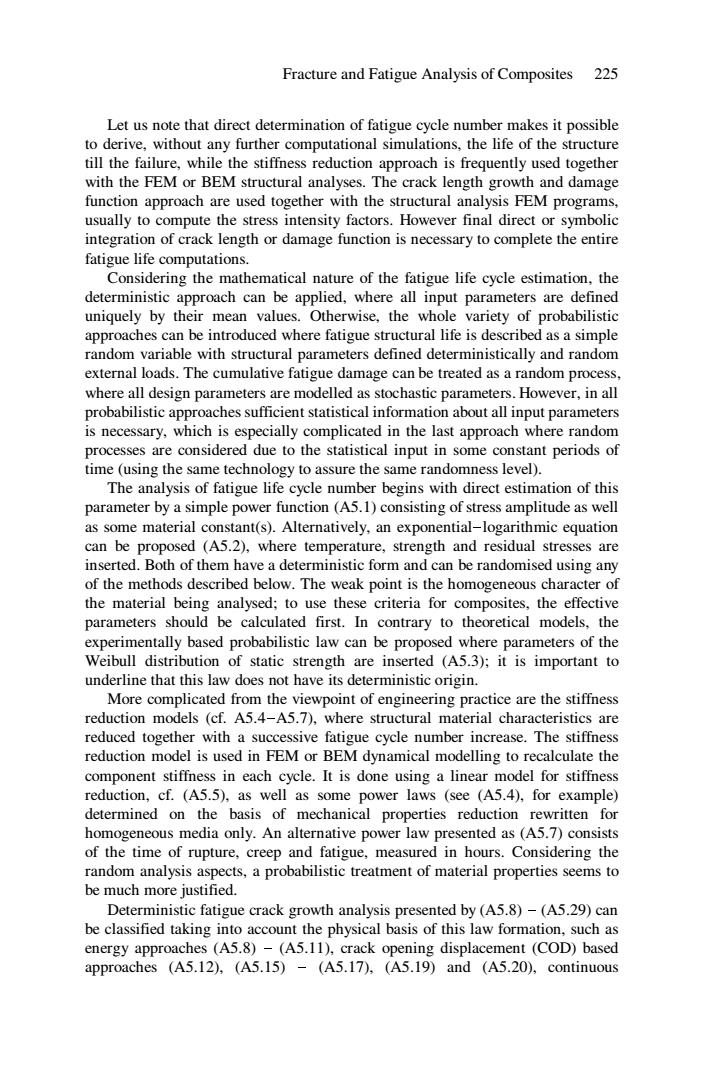正在加载图片...

Fracture and Fatigue Analysis of Composites 225 Let us note that direct determination of fatigue cycle number makes it possible to derive,without any further computational simulations,the life of the structure till the failure,while the stiffness reduction approach is frequently used together with the FEM or BEM structural analyses.The crack length growth and damage function approach are used together with the structural analysis FEM programs, usually to compute the stress intensity factors.However final direct or symbolic integration of crack length or damage function is necessary to complete the entire fatigue life computations. Considering the mathematical nature of the fatigue life cycle estimation,the deterministic approach can be applied,where all input parameters are defined uniquely by their mean values.Otherwise,the whole variety of probabilistic approaches can be introduced where fatigue structural life is described as a simple random variable with structural parameters defined deterministically and random external loads.The cumulative fatigue damage can be treated as a random process, where all design parameters are modelled as stochastic parameters.However,in all probabilistic approaches sufficient statistical information about all input parameters is necessary,which is especially complicated in the last approach where random processes are considered due to the statistical input in some constant periods of time(using the same technology to assure the same randomness level). The analysis of fatigue life cycle number begins with direct estimation of this parameter by a simple power function(A5.1)consisting of stress amplitude as well as some material constant(s).Alternatively,an exponential-logarithmic equation can be proposed (A5.2),where temperature,strength and residual stresses are inserted.Both of them have a deterministic form and can be randomised using any of the methods described below.The weak point is the homogeneous character of the material being analysed;to use these criteria for composites,the effective parameters should be calculated first.In contrary to theoretical models,the experimentally based probabilistic law can be proposed where parameters of the Weibull distribution of static strength are inserted (A5.3);it is important to underline that this law does not have its deterministic origin. More complicated from the viewpoint of engineering practice are the stiffness reduction models (cf.A5.4-A5.7),where structural material characteristics are reduced together with a successive fatigue cycle number increase.The stiffness reduction model is used in FEM or BEM dynamical modelling to recalculate the component stiffness in each cycle.It is done using a linear model for stiffness reduction,cf.(A5.5),as well as some power laws (see (A5.4),for example) determined on the basis of mechanical properties reduction rewritten for homogeneous media only.An alternative power law presented as(A5.7)consists of the time of rupture,creep and fatigue,measured in hours.Considering the random analysis aspects,a probabilistic treatment of material properties seems to be much more justified. Deterministic fatigue crack growth analysis presented by(A5.8)-(A5.29)can be classified taking into account the physical basis of this law formation,such as energy approaches (A5.8)-(A5.11),crack opening displacement (COD)based approaches (A5.12),(A5.15)-(A5.17),(A5.19)and (A5.20),continuousFracture and Fatigue Analysis of Composites 225 Let us note that direct determination of fatigue cycle number makes it possible to derive, without any further computational simulations, the life of the structure till the failure, while the stiffness reduction approach is frequently used together with the FEM or BEM structural analyses. The crack length growth and damage function approach are used together with the structural analysis FEM programs, usually to compute the stress intensity factors. However final direct or symbolic integration of crack length or damage function is necessary to complete the entire fatigue life computations. Considering the mathematical nature of the fatigue life cycle estimation, the deterministic approach can be applied, where all input parameters are defined uniquely by their mean values. Otherwise, the whole variety of probabilistic approaches can be introduced where fatigue structural life is described as a simple random variable with structural parameters defined deterministically and random external loads. The cumulative fatigue damage can be treated as a random process, where all design parameters are modelled as stochastic parameters. However, in all probabilistic approaches sufficient statistical information about all input parameters is necessary, which is especially complicated in the last approach where random processes are considered due to the statistical input in some constant periods of time (using the same technology to assure the same randomness level). The analysis of fatigue life cycle number begins with direct estimation of this parameter by a simple power function (A5.1) consisting of stress amplitude as well as some material constant(s). Alternatively, an exponential-logarithmic equation can be proposed (A5.2), where temperature, strength and residual stresses are inserted. Both of them have a deterministic form and can be randomised using any of the methods described below. The weak point is the homogeneous character of the material being analysed; to use these criteria for composites, the effective parameters should be calculated first. In contrary to theoretical models, the experimentally based probabilistic law can be proposed where parameters of the Weibull distribution of static strength are inserted (A5.3); it is important to underline that this law does not have its deterministic origin. More complicated from the viewpoint of engineering practice are the stiffness reduction models (cf. A5.4-A5.7), where structural material characteristics are reduced together with a successive fatigue cycle number increase. The stiffness reduction model is used in FEM or BEM dynamical modelling to recalculate the component stiffness in each cycle. It is done using a linear model for stiffness reduction, cf. (A5.5), as well as some power laws (see (A5.4), for example) determined on the basis of mechanical properties reduction rewritten for homogeneous media only. An alternative power law presented as (A5.7) consists of the time of rupture, creep and fatigue, measured in hours. Considering the random analysis aspects, a probabilistic treatment of material properties seems to be much more justified. Deterministic fatigue crack growth analysis presented by (A5.8) - (A5.29) can be classified taking into account the physical basis of this law formation, such as energy approaches (A5.8) - (A5.11), crack opening displacement (COD) based approaches (A5.12), (A5.15) - (A5.17), (A5.19) and (A5.20), continuous